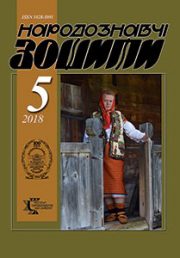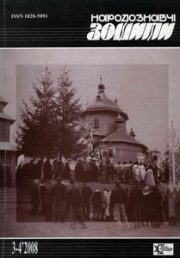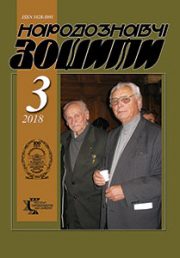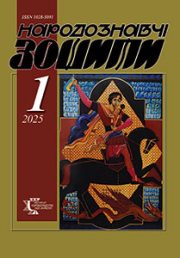The Ethnology Notebooks. 2024. № 2 (176), 369—376
UDK 730.071.1(477.83-25)”17/18″Г.Вітвер:378(436.1):930.253
DOI https://doi.org/10.15407/nz2024.02.369
ACADEMIC EDUCATION OF HARTMAN WITWER: IN LIGHT OF ARCHIVAL SOURCES
BONDAR Pavlo
- ORCID ID: https://orcid.org/0000-0002-3407-3043
- Senior Lecturer,
- Lviv National Academy of Arts,
- Department of Monumental and Decorative Sculpture,
- 38, Kubiyovych Street, 79011, Lviv, Ukraine,
- e-mail: p.bondar@lnam.edu.ua
Abstract. Hartman Witwer — Lviv sculptor, native of Imst (Austria), one of the prominent representatives of classicism in Western Ukrainіаn lands, whose personality is still uderstudied.
Problem Statement: Until now there have been known neither documentary evidence of H. Witwer’s professional education. Information about his academic training was based solely on the personal assertion of the sculptor, carved on the tombstone of Katerina Yablonovska in Lviv (completed in 1806).
Purpose: The aim of the article is to investigate the period of H. Witwer’s education at the Vienna Academy of Arts, to publish unknown documents and to consider factors that influenced the formation of H. Witwer during his studies in Vienna (environment, aesthetic ideal, pedagogical methods, faculty).
Methods: The method of scientific research was applied in studying archival sources. Historical-descriptive and comparative methods were used to analyze the influence of the artistic-pedagogical environment of the Vienna Academy of Arts on the formation of the creative personality of H. Witwer.
Results: Previously unknown documents dealing with H. Witwer’s education at the Vienna Academy of Arts have been published. The features of the educational process of the academy in the late 18th — early 19th centuries have been outlined. The artistic figures of F.A. Zauner, J.M. Fischer, and A. Canova, who had a significant influence on the formation of H. Witwer’s creative personality, have been considered.
Conclusion: H. Witwer studied at the sculpture department of the Vienna Academy of Arts for at least 5 years between 797 and 1802. The young sculptor mastered the artistic means of classicism style, which was predominant at that time. His education was comprehensive and included practical and theoretical knowledge. The creative personality of H. Witwer was mainly formed under the guidance of academy professors F.A. Zauner and J.M. Fischer, as well as the reputable Italian sculptor A. Canova, who had a special influence on the artistic processes of that time in Vienna. In 1802, H. Witwer was awarded the academic prize «Gundel-Preis» for the bas-relief «Philoctetes and Machaon».
Keywords: Hartman Witwer, Vienna Academy of Arts, classicism, antiquity, eclectic method, «Gundel-Preis» award.
Received 26.02.2024
REFERENCES
- Biriulov, Yu. (2015). Lviv sculpture from early classicism to avant-gardism (mid-18th — mid-twentieth century). Lviv: Apriori [in Ukrainian].
- Kupchynska, L. (1998). Vien Academy of fine arts and studying there Ukrainian and Polish youth from Halychyna. Zapysky Naukovoho Tovarystva imeni Shevchenka (Vol. ССХХХVІ, pp. 155—173). Lviv [in Ukrainian].
- Kupchynska, L. (2015). Contibution of Yan Tysevych in investigation of Vien academy of arts activity. The Ethnology notebooks, 4, 805—812 [in Ukrainian].
- University Archives of the Academy of Fine Arts Vienna, administrative files fol. 181/182 ex 1802 (price topic), administrative files fol. 187/188, 194 ex 1802 (prices) [in German].
- University Archives of the Academy of Fine Arts Vienna, administrative files fol. 181 ex 1802, minutes of the meeting of 1802 fol. 38 (price). Price book:35 [in German].
- University Archives of the Academy of Fine Arts Vienna, Name directory. Their students attending the Academy of Fine Arts in the painter-sculptor and landscape Schuke 1810—1812 (matr. vol. 3). Fol. 128 [in German].
- Burg, H. (2018). The sculptor Franz Anton Zauner and his time. Inktank publishing [in German].
- Poch-Kalous, M. (1949). Johann Martin Fischer Vienna’s sculptural representative of Josephinism. Vienna: Erwin Muller published [in German].
- Bodnar, P. (2023). Lviv sculptor Hartman Vitver and his artistic family from Imst.
- Novi arhivni znahidky ta doslidzennya. Visnyk Lvivskoi natsionalnoi akademii mystectv (Issue 30, pp. 23—29). Lviv [in Ukrainian].
- Thieme, U., & Becker, F. (1947). General lexikon of visual artists from the Antiquiti to the present (Vol. XXXVI). Leipzig: W. Engelmann [in German].
- (1917). The Imperial — Royal. Academy of Fine Arts in Vienna from 1892—1917. Vienna [in German].
- Pevsner, N. (1940). Academies of Art: Past and Present. Cambridge.
- Fontaine, A. (1909). Art doctrines in France: Painters, amateurs, critics from Poussin to Diderot. Parice [in French].
- Scheu, Mariana. Dissertation «Johann Baptist Hagenauer (1732—1810) and his Student circle. Paths of sculpture in the 18 and 19 centuries». Vienna, 2014. Retrieved from: https://docplayer.org/113801552-Dissertation-titel-der-dissertation-johann-baptist-hagenauer-und-sein-schuelerkreis-wege-der-bildhauerei-im-18-und-19.html (Last accessed: 08.02.2024) [in German].
- Vinkelman, Y.Y. (1990). About artistic ideal of beauty. Kyiv: Mystectvo [in Ukrainian].
- D’ Este, A. (1864). Memoirs of Antonio Canova, written by Antonio D’ Este and published, edited by Alessandro D’ Este. Florence, F. Le Monnier. Retrieved from: https://archive.org/stream/memoriediantonio00este/memoriediantonio00este_djvu.txt (Last accessed: 09.02.2024) [in Italian].
- Toman, Rolf (Ed.). (2000). Classicism and Romanticism — architekture, sculpture, paintings, drawings. — 1750—1848. Cologne [in German].







